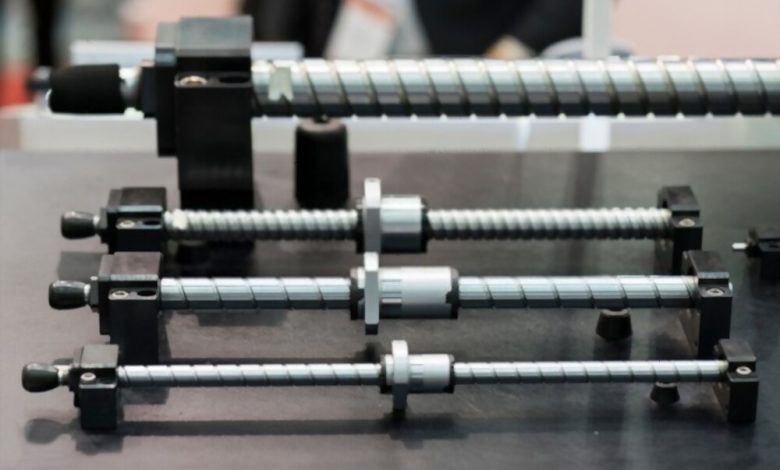
The ball screws play an important role in numerous manufacturing and production industries to switch the direction of motion, from linear motion to rotational motion or rotational to linear. The notable benefit of using ball screws is to complete the movement with minimum interference and friction. Ball screw are available in different types, styles, and sizes.
Well, a ball screwis a mechanical device that comprises a screw and a nut, each with mechanical grooves, and balls. The balls roll between grooves for establishing a connection between the screw and the nut. There is no friction as it doesn’t slide, but roll. This further adds a conclusive impact both on the device and improves the efficacy of any running procedure.
Ball screws have the capability of transforming the rotating movement into precise linear movement, which some of the time arrives at 90%. Thus, it remarkably provides reliable outcomes and is easy to clean. Greasing the device from time to time can enhance the performance operation.
As compared to those roller screws or acme screws, it’s inhabited with various benefits. The working standard for this tool is similar to ball bearings. Between the threads of the nut and the screw, balls move along a spiral trajectory, falling into the external and internal return channels. With 90 percent effectiveness, With regards to ball screws, there is some critical specification to comprehend.
In this guide, we explain in detail – the basics of ball screw and their various applications.
So, let’s get started!
What are Ball Screws?
Ball screws are a mechanical device that transforms rotational motion into linear motion. It has high overload characteristics of the ball screw and very high efficiency. The screw and nut are produced in pairs, fitted with very tight tolerances, and can be used in equipment where very high precision is required. The ball nut is usually slightly larger than the slide nut due to the recirculation channels of the balls located in it.
Ball screws are often used in aircraft and rocketry to move steering surfaces, as well as in cars to drive the steering rack from an electric steering motor. It’s also used in applications like – precision mechanical engineering, such as CNC machines, robots, assembly lines, component installers, as well as in mechanical presses, injection molding machines, etc.
Purpose of Ball Screws
All types of ball screws are designed to convert rotary motion into linear motion. Structurally, they consist of a body and a lead screw. They all carry different technical characteristics and vary in sizes.
The main advantage of lessening the friction during handling operations. This, as a result, provides smooth movement and there would be no sharp bumps in its position while running operation.
In addition, rolling is not applied to sliding friction relative to the pin and housing to achieve a smooth ride. To achieve the desired result, the working principle is similar to ball bearing (as mentioned above). Such a scheme increases the overload characteristics of ball screws for various applications, significantly increases efficiency.
What are the Main Components of Ball Screw?
When it comes to ball screws, they are made of the following components. Understanding each component function provides you with a better perception of the mechanism’s purpose.
- Screw with helical grooves: it’s designed to convert rotary motion into translational motion. A thread is formed on its surface, the main characteristic is its pitch;
- Nut
- Balls: It’s required for smooth movement of the body relative to the axis of the lead screw. Plastic, steel, or ceramic are used to design balls.
How a Ball Screw Works?
In a ball screw, the balls begin to roll along the helical grooves, pushing the nut to produce continuous movement, after which they fall into the channel. The balls show their movement into the nut’s ball return system and proceed to drive to the linear path. Many variations come on the way of ball screws, depending on the proposed applications.
Reasons for Using Ball Screws in Various Applications
There are a number of reasons due to which many manufacturers are paying attention to the ball screws. Here are the following reasons:
Carrying Capacity: With heavy machining, the ball screw shouldn’t bend between the supports or vibrate. Otherwise, this will affect the accuracy of the workpiece, which influences the machining conditions and depth of cut. As a result, the processing time will increase and productivity will decrease.
Positioning Accuracy: The accuracy of the movement of the machine unit depends on the accuracy of the ball screw. If there are backlashes or rough accuracy, this will also affect the accuracy of the workpieces.
Accuracy of Repeatability: It depends on the manufacturing accuracy of the ball screw.
Travel Speed: In modern CNC machines, speed and acceleration come to the fore, since high speed is required on fast movements, as well as on working strokes, especially in high-speed machining.
Smooth Running: The ball screw must ensure the smooth movement of the machine unit. Otherwise, it’ll also affect the processing accuracy. Jumps are not permissible, especially at the time of starting the movement of the node.
Durability: The ball screw assembly must have a long service life under the design loads since its rapid wear will lead to unplanned downtime for repairs.
Lack of Heating: During the operation of the machine, the ball screws shouldn’t heat up. Otherwise, there will be rapid wear of the ball screw itself and affect the accuracy of the machine.
Ball Screw Applications
The relative simplicity of the design and the possibility of manufacturing a ball screw with different characteristics expands the scope of its application. Nowadays, ball screws are integral components of various machines.
Due to their versatility, ball screws can’t only be installed in machines. Smooth running and practically zero friction make them indispensable components in precision measuring instruments, medical installations, and mechanical engineering.
This is made possible by the following properties:
- Minimization of friction losses;
- High load capacity factor with small dimensions of the structure;
- Low inertia. It’s the movement of the body that occurs simultaneously with the rotation of the screw;
- Less noise and smooth running.
Wrapping Up
To create machine tools with programmed numerical control, it is necessary to use ball screws. To create machine tools with programmed numerical control, it’s necessary to use ball screws. They’re not only different in appearance but also equipped with a different design. Before choosing one specific model, it’s recommended that you understand the structure of the ball in advance.



